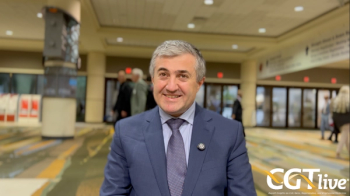
Positive Safety Profile Reported for Atezolizumab/Axi-Cel Combo in DLBCL
A manageable safety profile was observed for the combination of atezolizumab and the anti-CD19 chimeric antigen receptor T-cell therapy, axicabtagene ciloleucel, in patients with refractory diffuse large B-cell lymphoma.
Caron Jacobson, MD
A manageable safety profile was observed for the combination of atezolizumab (Tecentriq) and the anti-CD19 chimeric antigen receptor (CAR) T-cell therapy, axicabtagene ciloleucel (axi-cel; Yescarta), in patients with refractory diffuse large B-cell lymphoma (DLBCL), according to findings from the ZUMA-6 trial (NCT02926833), presented during the 2020 American Association for Cancer Research Virtual Annual Meeting I, April 27 to 28, 2020.1
The phase 1/2 study evaluated the safety and efficacy of the combination, and the trial stratified 34 patients into 3 cohorts. After undergoing leukapheresis, all cohorts received a conditioning dose of 30 mg/m2/day of fludarabine plus cyclophosphamide at 500 mg/m2/day for 3 days, followed by an axi-cel infusion of 2 × 106 CAR T cells/kg. In phase 1, 1200 mg of atezolizumab was administered every 21 days for 4 doses, starting on either day 21, 14, or 1 post axi-cel infusion for cohorts 1, 2, and 3, respectively. After safety review, 28 patients were treated in phase 2 of the study, in which they received the phase 1 atezolizumab/axi-cel dosing schedule of cohort 3.
“The rationale for this study is that after T-cell infusion and upon T-cell activation, CAR T cells will upregulate PD-1,” lead author Caron Jacobson, MD, medical director of the Immune Effector Cell Therapy Program at Dana-Farber Cancer Institute and assistant professor of medicine at Harvard Medical School in Boston, Massachusetts, said during the presentation. The investigators administered atezolizumab in concordance with the upregulation of PD-1, which happens after T-cell activation. Checkpoint blockade may enhance the activity of CAR T cells.
The primary end point was incidence of dose-limiting toxicities (DLTs) for phase I and complete response (CR) rate for phase II. Secondary end points included incidence of adverse events (AEs), objective response rate, and CAR T-cell levels in the blood. Jacobson presented pooled data for the patients treated in phase I cohort 3 and phase II (n = 28). Median follow-up was 10.2 months.
Jacobson said results from phase I were presented at the American Society of Hematology Annual Meeting in 2018.2 For this cohort of patients, the median age was 58 years (range, 42-71) and all patients had an ECOG performance status of 0 or 1. The majority of patients had advanced-stage disease, 46% of patients had an International Prognostic Index score of 3 or 4, and 50% of patients had received 3 or more lines of prior therapy.
“All 34 patients enrolled in the phase I and II portions of the study received axi-cel and at least 1 dose of atezolizumab and 24 of 34 patients [74%] received all 4 doses of atezolizumab,” Jacobson said.
Baseline tumor biopsies were evaluated for PD-L1 expression using the Ventana PD-L1 assay. The median baseline tumor cell PD-L1 H score was 40 (range, 0-240). According to the immune infiltrate intensity score, 25% of patients had weak staining, 25% had moderate staining, and 39% had strong staining.
The most common grade 3 or greater treatment-emergent adverse events (TRAEs) occurring in 10% or more of patients was neutropenia (61%), anemia (54%), thrombocytopenia (36%) encephalopathy (25%), and hypophosphatemia (21%). Jacobson said that 39% of grade 3 or greater AEs were attributed to axi-cel, 14% were attributed to atezolizumab, and 25% were attributed to both.
One patient in phase I cohort 3 experienced a DLT of grade 4 thrombocytopenia and neutropenia that lasted longer than 30 days. There was 1 case of grade 5 AE of multiple organ dysfunction unrelated to axi-cel or atezolizumab reported in phase II. The patient developed cytomegalovirus pneumonia and viremia on day 22 following axi-cel infusion that subsequently progressed despite treatment with ganciclovir and was ultimately fatal.
Ninety-six percent of patients reported cytokine release syndrome (CRS) of any grade and 4% of patients experienced grade 3 CRS. There were no grade 4 or 5 CRS events observed. Median onset of CRS was 2 days and median duration was 7 days.
Sixty-eight percent of patients experienced any-grade neurologic events, with 29% experiencing grade 3 or greater severity. The most common neurologic events of any grade were encephalopathy (36%) and aphasia (14%). Median time to onset was 6 days (range, 1-23) and the median duration was 9 days (range, 2-60). Two neurologic events were ongoing at the time of data cut off: 1 case of grade 1 tremor and 1 case of grade 2 hypoesthesia.
Responses were seen in 75% of patients, and at the time of data cut off, 46% had ongoing response. “The median duration of response, progression-free survival, and overall survival have not been reached,” Jacobson said.
When considering all phase I and II portions of the study, 4 patients experienced late conversion, with 3 partial responses converting to complete responses and 1 stable disease converting to complete response.
Product characteristics were generally similar in ZUMA-6 compared with an earlier study, ZUMA-1.3 Jacobson reported that on a whole the, the CD4 to CD8 ratio for ZUMA-6 was similar with ZUMA-1 and there were no meaningful associations between product characteristics in clinical responses.
The kinetics of CAR T-cell expansion were also similar between ZUMA-6 and ZUMA-1 despite the addition of atezolizumab. The investigators reported that median area under the curve was also similar between the 2 studies.
Jacobson said that PD-L1 blockade with atezolizumab after axi-cel infusion has a manageable safety profile similar to that observed in the previous ZUMA-1 trial, with no significant incidence of AEs. Further, efficacy outcomes of axi-cel in combination with atezolizumab appeared to be comparable with those observed in patients treated with axi-cel alone.
“Additional studies involving axi-cel in combination with atezolizumab may be needed to establish an interaction between timing of checkpoint blockade and CAR T-cell treatment,” Jacobson concluded.
References
- Jacobson CA, Westin JR, Miklos DB, et al. Phase 1/2 primary analysis of ZUMA-6: Axicabtagene ciloleucel (Axi-Cel) in combination With atezolizumab (Atezo) for the treatment of patients (Pts) with refractory diffuse large B cell lymphoma (DLBCL). Presented at: 2020 American Association for Cancer Research Virtual Annual Meeting I: Virtual; April 27-28, 2020. Abstract CT055. bit.ly/3eZDfb4
- Jacobson CA, Locke FL, Miklos DB, et al. End of phase 1 results from zuma-6: axicabtagene ciloleucel (Axi-Cel) in combination with atezolizumab for the treatment of patients with refractory diffuse large B cell lymphoma. Blood. 2018;132(suppl 1; abstr 626). doi: 10.1182/blood-2018-99-111523
- Neelapu SS, Locke FL, Bartlett NL, et al. Axicabtagene ciloleucel CAR T-cell therapy in refractory large B-cell lymphoma. N Engl J Med. 2017;377(26):2531-2544. doi: 10.1056/NEJMoa170744
Newsletter
Stay at the forefront of cutting-edge science with CGT—your direct line to expert insights, breakthrough data, and real-time coverage of the latest advancements in cell and gene therapy.

















































